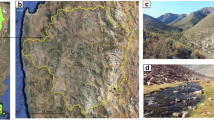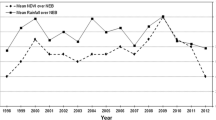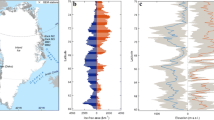Abstract
The Tibetan Plateau, a unique cold and dry region recognized as the Earth’s third pole, is primarily composed of alpine grasslands (>60 %). While a warming climate in the plateau is being recorded, phenology of alpine grasslands and its climatic dependencies are less investigated. This study tests the feasibility of the frequently observed Moderate Resolution Imaging Spectroradiometer (MODIS) time series (500 m, 8 days) in examining alpine phenology in the plateau. A set of phenological metrics are extracted from the MODIS Normalized Difference Vegetation Index (NDVI) series in each year, 2000–2010. A nonparametric Mann-Kendall trend analysis is performed to find the trends of these phenological metrics, which are then linked to monthly climatic records in the growing season. Opposite trends of phenological change are observed between the east and west of the plateau, with delayed start of season, peak date, and end of season in the west and advanced phenophases in the east. The correlation analysis indicates that precipitation, with a decreasing trend in the west and increasing trend in the east, may serve as the primary driver of the onset and peak dates of greenness. Temperature increases all over the plateau. While the delay of the end of season in the west could be related to higher late-season temperature, its advance in the east needs further investigation in this unique cold region. This study demonstrates that frequent satellite observations are able to extract phenological features of alpine grasslands and to provide spatiotemporally detailed base information for long-term monitoring on the plateau under rapid climate change.







Similar content being viewed by others
References
Academician of Chinese Academy of Sciences (ACAS) (2001) Vegetation atlas of China. Science Press, Beijing (in Chinese)
Bao Y, Tang L, Li C, Shao Y, Tao S, Yang L (2010) An ice-core record of vegetation and climate changes in the central Tibetan Plateau during the last 550 years. Chin Sci Bull 55:1169–1177
Betancourt JL, Schwartz MD, Breshears DD, Cayan DR, Dettinger MD, Inouye DW, Post E, Reed BC (2005) Implementing a U.S. national phenology network. Eos Trans Am Geophys Union 86:539
Chmielewski FM, Rötzer T (2002) Annual and spatial variability of the beginning of growing season in Europe in relation to air temperature changes. Clim Res 19:257–264
de Beurs KM, Henebry GM (2004a) Land surface phenology, climatic variation, and institutional change: analyzing agricultural land cover change in Kazakhstan. Remote Sens Environ 89:497–509
de Beurs KM, Henebry GM (2004b) Trend analysis of the pathfinder AVHRR Land (PAL) NDVI data for the deserts of Central Asia. IEEE Geosci Remote Sens Lett 1:282–286
Ding M, Zhang Y, Liu L, Zhang W, Wang Z, Bai W (2007) The relationship between NDVI and precipitation on the Tibetan Plateau. J Geogr Sci 17:259–268
Gordo O, Sanz JJ (2010) Impact of climate change on plant phenology in Mediterranean ecosystems. Glob Chang Biol 16:1082–1106
Harris RB (2010) Rangeland degradation on the Qinghai-Tibetan plateau: a review of the evidence of its magnitude and causes. J Arid Environ 74:1–12
Hirsch RM, Slack JR (1984) A nonparametric trend test for seasonal data with serial dependence. Water Resour Res 20:727–732
Hirsch RM, Alexander EB, Smith RA (1991) Section of methods for the detection and estimation of trends in water quality. Water Resour Res 27:803–813
IPCC (2007) Climate change 2007: the physical science basis. In: Solomon S, Qin D, Manning M, Chen Z, Marquis M, Averyt KB, Tignor M, Miller HL (eds) Contribution of Working Group I to the Fourth Assessment Report of the Intergovernmental Panel on Climate Change. Cambridge University Press, Cambridge
Jin Z, Zhuang Q, He J, Luo T, Shi Y (2013) Phenology shift from 1989 to 2009 on the Tibetan Plateau: an analysis with a process-based soil physical modal and remote sensing data. Climate Change. doi:10.1007/s10584-013-0722-7
Jönsson P, Eklundh L (2004) TIMESAT—a program for analyzing time-series of satellite sensor data. Comput Geosci 30:833–845
Liang S, Chen J, Jin X, Wan L, Gong B (2007) Regularity of vegetation coverage changes in the Tibetan Plateau in the past 21 years. Adv Earth Sci 22:33–40 (in Chinese)
Liao J, Shen G, Li Y (2013) Lake variations in response to climate change in the Tibetan Plateau in the past 40 years. Int J Digit Earth 6:534–549
Lin Z, Zhao X (1996) Spatial characteristics of changes in temperature and precipitation of the Qinghai-Xizang (Tibet) Plateau. Sci China Ser D 39:442–448
Liu X, Chen B (2000) Climatic warming in the Tibetan Plateau during recent decades. Int J Climatol 20:1729–1742
Liu X, Yin Z, Shao X, Qin N (2006) Temporal trends and variability of daily maximum and minimum, extreme temperature events, and growing season length over the eastern and central Tibetan Plateau during 1961–2003. J Geophys Res 111(D19109):1–19
Mao F, Zhang Y, Hou Y, Tang S, Lu Z, Zhang J (2008) Evaluation of grassland degradation in Naqu, Northern Tibet. Chin J Appl Ecol 19:278–284 (in Chinese)
Myneni RB, Keeling CD, Tucker CJ, Asrar G, Nemani RR (1997) Increased plant growth in the northern high latitudes from 1981 to 1991. Nature 386:688–702
Nemani R, Keeling CD, Hashimoto H, Jolly WM, Piper SC, Tucker CJ, Myneni RB, Running SW (2003) Climate-driven increases in global terrestrial net primary production from 1982 to 1999. Science 300:1560–1563
Önöz B, Bayazit M (2002) The power of statistical tests for trend detection. Turk J Eng Environ Sci 27:247–251
Piao S, Fang J, Zhou L, Guo Q, Henderson M, Ji W, Li Y, Tao S (2003) Interannual variations of monthly and seasonal normalized difference vegetation index (NDVI) in China from 1982 to 1999. J Geophys Res 108(D14,401):1–13
Sato T (2001) Spatial and temporal variation of frozen ground and snow cover in the eastern Tibetan Plateau. J Meteorol Soc Jpn 79:519–534
Savitzky A, Golay MJE (1964) Smoothing and differentiation of data by simplified least squares procedures. Anal Chem 36:1627–1639
Thompson LG, Mosley-Thompson E, Brecher H, Davis M, Leon B, Les D, Lin P, Mashiotta T, Mountain K (2006) Abrupt tropical climate change: past and present. Proc Natl Acad Sci U S A 103:10536–10543
Tucker CJ, Slayback DA, Pinzon JE, Los SO, Myneni RB, Taylor MG (2001) Higher northern latitude normalized difference vegetation index and growing season trends from 1982 to 1999. Int J Biometerol 45:184–190
Wang B, Bao Q, Hoskins B, Wu G, Liu Y (2008) Tibetan Plateau warming and precipitation changes in East Asia. Geophys Res Lett 35(L14702):1–5
Wang C, Fritschi FB, Stacey G, Yang Z (2011) Phenology-based assessment of energy crops in North American tallgrass prairie. Ann Am Assoc Geogr 101:742–751
Wang C, Hunt ER, Zhang L, Guo H (2013) Spatial distributions of C3 and C4 grass functional types in the U.S. Great Plains and their dependency on inter-annual climate variability. Remote Sens Environ 138:90–101
Wang C, Guo H, Zhang L, Qiu Y, Sun Z, Liao J, Liu G, Zhang Y (2013) Improved alpine grassland mapping in the Tibetan Plateau with MODIS time series: a phenology perspective. Int J Digit Earth. doi:10.1080/17538947.2013.860198
Wessels KJ, van den Bergh F, Scholes RJ (2012) Limits to detectability of land degradation by trend analysis of vegetation index data. Remote Sens Environ 125:10–22
Wu B (2005) Weakening of Indian summer monsoon in recent decades. Adv Atmos Sci 22:21–29
Xu X, Chen H, Levy JK (2008a) Spatiotemporal vegetation cover variations in the Qinghai-Tibet Plateau under global climate change. Chin Sci Bull 53:915–922
Xu Z, Gong T, Li J (2008b) Decadal trend of climate in the Tibetan Plateau—regional temperature and precipitation. Hydrol Process 22:3056–3065
Yang Y, Piao S (2006) Variations in grassland vegetation cover in relation to climatic factors on the Tibetan Plateau. J Plant Ecol 30:1–8 (in Chinese)
Yao T, Thompson L, Yang W, Yu W, Gao Y, Guo X, Yang X, Duan K, Zhao H, Xu B, Pu J, Lu A, Xiang Y, Kattel DB, Joswiak D (2012) Different glacier status with atmospheric circulations in Tibetan Plateau and surroundings. Nat Clim Chang Lett. doi:10.1038/NCLIMATE1580
Yu H, Xu J (2009) Impacts of climate change on vegetation in the Tibetan Plateau: a review. Chin J Ecol 28:747–754 (in Chinese)
Yu H, Luedeling E, Xu J (2010) Winter and spring warming result in delayed spring phenology on the Tibetan Plateau. PNAS Early Edition 1–6
Yu H, Xu J, Okuto E, Luedeling E (2012) Seasonal response of grasslands to climate change on the Tibetan Plateau. PLoS ONE 7(11):e49230. doi:10.1371/journal.pone.0049230
Zhang L, Guo H, Ji L, Lei L, Wang C, Yan D, Li B, Li J (2013) Vegetation greenness trend (2000 to 2009) and the climate controls in the Qinghai-Tibetan Plateau. J Appl Remote Sens 7:073572–073572
Zhang Y, Li B, Zheng D (2002) Extent and area of the Tibetan Plateau. Geogr Res 21:1–8 (in Chinese)
Zhang J, Yao F, Zheng L, Yang L (2007) Evaluation of grassland dynamics in the Northern-Tibet Plateau of China using remote sensing and climate data. Sensors 7:3312–3328
Zhang G, Zhang Y, Dong J, Xiao X (2013) Green-up dates in the Tibetan Plateau have continuously advanced from 1982 to 2011. PNAS 110:4309–4314
Zhao SQ (1994) Geography of China: environment, resources, population and development. Wiley, New York
Zheng D, Zhang R, Yang Q (1979) On the natural zonation in the Qinghai-Xizang Plateau. Acta Geograph Sin 34:1–11 (in Chinese)
Zhong L, Ma Y, Salama MS, Su Z (2010) Assessment of vegetation dynamics and their response to variations in precipitation and temperature in the Tibetan Plateau. Clim Chang 103:519–535
Acknowledgments
The study was supported by the Open Research Fund of Key Laboratory of Digital Earth Science, Institute of Remote Sensing and Digital Earth, Chinese Academy of Sciences (No. 2013LDE002), and the International Cooperation and Exchanges NSFC (No. 41120114001).
Author information
Authors and Affiliations
Corresponding author
Rights and permissions
About this article
Cite this article
Wang, C., Guo, H., Zhang, L. et al. Assessing phenological change and climatic control of alpine grasslands in the Tibetan Plateau with MODIS time series. Int J Biometeorol 59, 11–23 (2015). https://doi.org/10.1007/s00484-014-0817-5
Received:
Revised:
Accepted:
Published:
Issue Date:
DOI: https://doi.org/10.1007/s00484-014-0817-5




